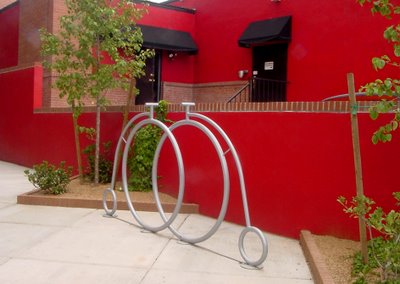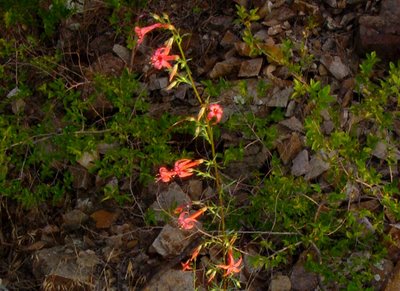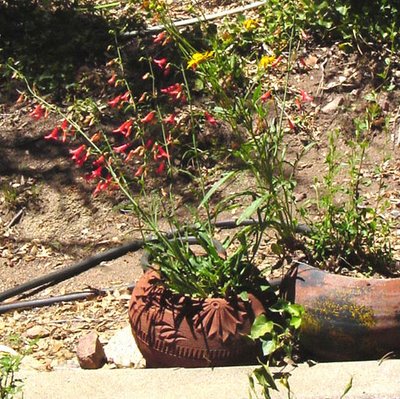As I 've explained previously, I do two kinds of gardening on my Prescott hillside. For bright, colorful annuals and a few perennials that want Real Soil, it's pots. For plantings in the ground, local wildflowers, many of which are quite spectacular.

For example, the most prolific Indian paint brush I've ever seen! Pictured above, the plant on April 18, just beginning to flower. This is the end of May; it is still adding more blossoms, and this without a host plant (paint brush are semi-parasites.) I'm sure the secret to my wonderous paint brush is that it gets regular watering.


The bright reds of this plant are not actual blossoms, but, rather, modified leaves surrounding the working parts.

Pink. Fuschia. Red. Purple. Almost blue. And, I've heard, an occasional yellow. Those are the colors of upland Arizona penstemons. I've counted eight species that grow in the greater Prescott area, but perhaps the most outstanding is Palmer's penstemon. In a good year (meaning early spring rains), this pink beauty grows flower stalks up to 6 feet tall. Do peer into the throat of a blossom. See the guide lines for insects and that cool yellow beard?

The leaves give evidence that this is a plant for arid country. Not only are they somewhat waxy, but they are arranged down the stem to deliver what little water falls directly to the roots. Look for Palmer's penstemon out the Iron Springs Road, beside the road to Granite Basin or along the White Spar through the Prietas.

This penstemon is a spectabilis, I believe. Not a Prescott plant, but found higher up in the mountains. Doubtless a purchase from
Flagstaff Native Plant/Seed.
The last of my earliest penstemon -- psuedospectabilis or Arizona penstemon, another plant for arid country. The best local site for this plant is way out the Dosie Pit Road. These samples surely explain why British plant breeders adapted the penstemon into a really smashing cultivated garden favorite here and abroad!

Too bad that the desert four o'clock opens so late in the day, as it is another very attractive plant. I came in close on the flowers to show the bracts from which a daily blossom emerges. Only one seed per flower, but many blossoms -- and, given enough water, most of the seeds will sprout. This plant was grown from a neighborhood seed, BTW.

Coral bells were a perennial staple of my gardens back in Chicago; it turns out that they are also Arizona mountain natives! Though I paid good money to Watters for this plant, I did discover a small clump of white coral bells in a shaded rock outcropping along Mint Wash below the Granite Basin dam.

This is one of my own New Mexico locusts. Pretty flowers, but nasty thorns. New shrubs keep coming up from very long underground runners. However, I have a problem with a myriad of nasty juice-sucking critters that attach to the stems and kill them. Maybe the city is simply the wrong location for this locust!

Pretty little claret cup cactuses are mountain plants, adapted to elevations as high as 7000 ft. This means that, unlike most cactus, they are tough little guys who can survive winter snows, as can prickly pears.

Here is my great disappointment. A fine specimen of bear grass -- but instead of a
proper, tall flower stalk, my plant grew a crooked stem that hugged the ground. I've no idea why this is so!

And another admission of incompetence: I am totally unable to grow a sacred datura from seed. I have tried in pots. I have tried in the ground. Up the hill. Down by the road. No success. Bought this seedling at, you guessed it, Flagstaff Native Plants. Should have bought several. More garden wildflowers later, as they bloom.
 In Arizona you quickly learn that all the wild plants are both tough and opportunistic. Thus, as the chance of a deep frost has receded, my perennial wildflowers have sprung to life quickly, taking advantage of all that winter rain I've raved on about. My barbatus penstemon, for example, has started numerous flower stalks in the midst of all those leaves. R.E.D. and reliable, too. Is quite happy to get lots of water, though it doesn't count on it. That's unlike the tall pink Palmers penstemon, which can be drowned.
In Arizona you quickly learn that all the wild plants are both tough and opportunistic. Thus, as the chance of a deep frost has receded, my perennial wildflowers have sprung to life quickly, taking advantage of all that winter rain I've raved on about. My barbatus penstemon, for example, has started numerous flower stalks in the midst of all those leaves. R.E.D. and reliable, too. Is quite happy to get lots of water, though it doesn't count on it. That's unlike the tall pink Palmers penstemon, which can be drowned. Dainty leaves like these belong to our local wild columbine, which is a canary yellow -- and prolific, growing wherever seeds fall, if there's a bit of water. So I have a lot of yellow columbines. There's a red and yellow form that grows at lower elevations and up in the high country you might come across a blue and white Rocky Mountain variety, if you are lucky.
Dainty leaves like these belong to our local wild columbine, which is a canary yellow -- and prolific, growing wherever seeds fall, if there's a bit of water. So I have a lot of yellow columbines. There's a red and yellow form that grows at lower elevations and up in the high country you might come across a blue and white Rocky Mountain variety, if you are lucky. Old reliable this four o'clock is. Once it builds that huge tuber down at the middle of the earth, it will come up every year and bloom as long as it gets water -- not the usual pattern for perennials which focus on a fast crop of seeds to keep the species going.
Old reliable this four o'clock is. Once it builds that huge tuber down at the middle of the earth, it will come up every year and bloom as long as it gets water -- not the usual pattern for perennials which focus on a fast crop of seeds to keep the species going. This picture of two new, intertwined white evening primroses was taken 3/28/08. Already both plants have buds about to open. I have to keep my fingers crossed because the javelina find the roots quite tasty.
This picture of two new, intertwined white evening primroses was taken 3/28/08. Already both plants have buds about to open. I have to keep my fingers crossed because the javelina find the roots quite tasty. A very happy California poppy (sort of red) and above it, the pink Palmer's penstemon, with flower stalks taking off. As I've written before, the poppies are perennial here in Prescott if they get a certain amount of water and thus the plants grow to an impressive size.
A very happy California poppy (sort of red) and above it, the pink Palmer's penstemon, with flower stalks taking off. As I've written before, the poppies are perennial here in Prescott if they get a certain amount of water and thus the plants grow to an impressive size. I don't know if you recall this particular Indian paint brush plant. Last year, its red bracts stayed bright -- and multiplied for much of the summer, producing a spectacular show. The picture above is from 3/28. Now look below for the picture I took yesterday! Already on its way to another showy year.
I don't know if you recall this particular Indian paint brush plant. Last year, its red bracts stayed bright -- and multiplied for much of the summer, producing a spectacular show. The picture above is from 3/28. Now look below for the picture I took yesterday! Already on its way to another showy year. Linkages: Warren of Touch the Wind is up in Oregon and tonight showed some excellent street art, including an almost-elephant, with young on its back. And, on the subject of street art, Tombo has scored more colorful graffiti -- not the f**k or s**t kind, thank goodness; potty mouth is not only vulgar, it's a B-O-R-E! And PrescottStyle offers pictures from the McCain appearance.
Linkages: Warren of Touch the Wind is up in Oregon and tonight showed some excellent street art, including an almost-elephant, with young on its back. And, on the subject of street art, Tombo has scored more colorful graffiti -- not the f**k or s**t kind, thank goodness; potty mouth is not only vulgar, it's a B-O-R-E! And PrescottStyle offers pictures from the McCain appearance.



























